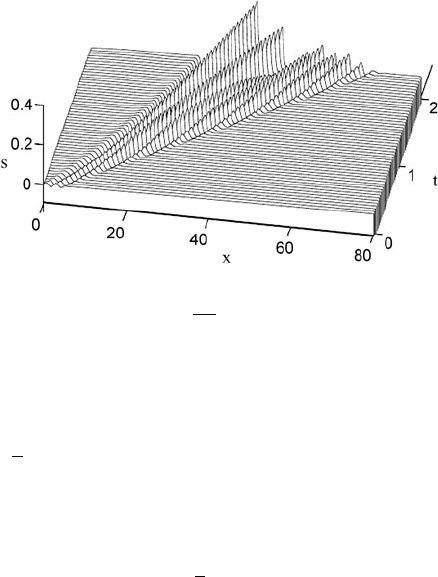Fowler A. Mathematical Geoscience
Подождите немного. Документ загружается.


290 5 Dunes
It is tempting to suppose that, writing ¯u =u
0
u,
τ =u
2
1 −s +
∞
−∞
K(x −ξ)
∂s
∂ξ
(ξ, t) dξ
. (5.102)
We would then have, with ε 1 and η = 1, u ≈
1
1−s
in (5.102). There is a subtle
point here concerning the modified stress. Insofar as we may wish to describe differ-
ent atmospheric or fluvial conditions (e.g., the difference between strong and weak
winds at different times of day, or rivers in normal or flood stage), we do want to
allow different choices of ¯u. However, such conditions also imply different values
of
¯
h, and the basis of the solution for the perturbed stress is that the mean depth (and
thus the mean velocity) do not vary. The value of u =
1
1−s
is a local column average,
whereas the u in (5.102) is in addition a horizontal average. Thus, given u
0
=¯u and
h
0
=
¯
h, we define
τ ≈1 −s +
∞
−∞
K(x −ξ)
∂s
∂ξ
(ξ, t) dξ, (5.103)
and the model consists of the Exner equation (5.101) and the Orr–Sommerfeld stress
formula (5.103). Variable ¯u is simply manifested in differing time scales for the
Exner equation.
We linearise by writing τ =1 +T , and then
s =
∞
−∞
ˆs(k,t)e
ikx
dk, T =
∞
−∞
ˆ
T(k,t)e
ikx
dk, (5.104)
so that
ˆs
t
+ikq
(1)
ˆ
T =0,
ˆ
T =−ˆs +2π
ˆ
Kikˆs,
(5.105)
and thus, using (5.99), solutions are proportional to e
σt
, where
σ =q
(1)
2πk
2
ˆ
K +ik
. (5.106)
When Re
ˆ
K>0, as for (5.99), the steady state is unstable, with Re σ ∼ k
4/3
as
k →∞. Specifically, the growth rate is
Re σ =
1
2
q
(1)c|k|
4/3
, (5.107)
while the wave speed is
−
Im σ
k
=q
(1)
1
2
√
3 c|k|
1/3
−1
; (5.108)
thus waves move downstream (except for very long waves).
5.6.3 Well-posedness
The effect of (5.103) is to cause increased τ where s
x
is positive, on the upstream
slopes of bumps. Since u is in phase with s, this implies τ leads u (i.e., τ is a max-

5.6 Eddy Viscosity Model 291
imum before s is); it is this phase lead which causes instability. However, the un-
bounded growth rate at large wave numbers is a sign of ill-posedness. Without some
stabilising mechanism, arbitrarily small disturbances can grow arbitrarily rapidly.
In reality, another effect of bed slope is important, and that is the fact that sediment
wants to roll downslope: in describing the Meyer-Peter/Müller result, no attention
was paid to the variations of bed slope itself.
For a particle of diameter D
s
at the bed, the streamflow exerts a force of approx-
imately τD
2
s
on it, and it is this force which causes motion. On a slope, there is
an additional force due to gravity, approximately −ρg D
3
s
s
x
. Thus the net stress
causing motion is actually
τ −ρg D
s
s
x
. (5.109)
In dimensionless terms, we therefore modify the bedload transport formula by writ-
ing
q =q(τ
e
), τ
e
=τ −βs
x
, (5.110)
where
β =
ρ D
s
ρ
w
h
0
S
. (5.111)
Typical values in water are ρ /ρ
w
≈2, D
s
∼10
−3
m, h
0
∼2m,S ∼10
−3
, whence
β ≈4; generally we will suppose that β ∼O(1).
The effect of this is to replace the definition of τ in (5.103)by
τ
e
=1 −s +
∞
−∞
K(x −ξ)
∂s
∂ξ
(ξ, t) dξ −βs
x
(5.112)
(together with (5.101)), and in the stability analysis,
ˆ
T =ˆs[−1 + 2πik
ˆ
K − ikβ],
whence
σ =q
(1)
−ik
1
2
√
3c|k|
1/3
−1
+
1
2
c|k|
4/3
−βk
2
. (5.113)
This exhibits the classical behaviour of a well-posed model. The system is stable at
high wave number, and the maximum growth rate is at k =(
c
3β
)
3/2
. This would be
the expected preferred wave number of the instability.
Figure 5.12 shows a numerical solution of the nonlinear Exner equation, showing
the growth of dunes from an initially localised disturbance. Because the expression
in (5.112) is only valid for small s, we can equivalently write
q(τ
e
) =q(τ −βs
x
) ≈q(τ) −Ds
x
, (5.114)
where
D =βq
(τ ) ≈βq
(1), (5.115)
and the equation has been solved in this form, with the diffusion coefficient D taken
as constant, i.e., s satisfies the equation
∂s
∂t
+
∂
∂x
q[1 −s +K ∗s
x
]=D
∂
2
s
∂x
2
. (5.116)

292 5 Dunes
Fig. 5.12 Development of the dune instability from an initial perturbation near x = 0 obtained
by solving (5.116)usingq(τ) = τ
3/2
, K =
μ
x
1/3
when x>0, K = 0 otherwise, with parameters
μ =9.57 and D =4.3. Separation occurs in this figure when t =0.8, after which the computation
is continued as described in the notes at the end of the chapter. Figure kindly provided by Mark
McGuinness
As the dunes grow, the model becomes invalid when τ −1 ∼O(1), and this hap-
pens when s ∼
1
μ
. This is a representative value for the elevation of both fluvial and
aeolian dunes, and is suggestive of the idea that it is the approach of τ towards zero
which controls eventual dune height. Additionally, when τ reaches zero, separation
occurs, and the model becomes invalid. Possible ways for dealing with this are out-
lined in the notes at the end of the chapter. A further issue is that the derivation
of (5.112) becomes invalid when s ∼
1
μ
, because then the thickness of the viscous
boundary layer in the Orr–Sommerfeld equation becomes comparable to the eleva-
tion of the dunes. This implies that the Orr–Sommerfeld equation should now be
solved in a domain where the lower boundary cannot be linearised about z =0, and
the Fourier method of solution can no longer be implemented. It is not clear whether
this will fundamentally change the nature of the resultant formula for the stress.
The numerical method used to solve (5.116) is a spectral method. Spectral meth-
ods for evolution equations of this sort are convenient, particularly when the integral
term is of convolution type, but they confuse the issue of what appropriate boundary
conditions for such equations should be. In the present case, it is not clear. For ae-
olian dunes, it is natural to pose conditions at a boundary representing a shore-line,
but it is then less clear how to deal with the integral term. The derivation of this term
already presumes an infinite sand domain, and it seems this is one of those questions
akin to the issue of posing boundary conditions for averaged equations, for example
for two-phase flow, where a hidden interchange of limits is occurring.
5.7 Mixing-Length Model for Aeolian Dunes
Measurements of turbulent fluid flow in pipes, as well as air flow in the atmosphere
(and also in wind tunnels), show that the assumption of constant eddy viscosity is

5.7 Mixing-Length Model for Aeolian Dunes 293
not a good one, and the basic shear velocity profile is not as simple as assumed in the
preceding section. In actual fact, the concept of eddy viscosity introduced by Prandtl
was based on the idea of momentum transport by eddies of different sizes, with
the transport rate (eddy viscosity) being proportional to eddy size. Evidently, this
must go to zero at a solid boundary, and the simplest description of this is Prandtl’s
mixing-length theory, described in Appendix B. In this section, we generalise the
previous approach a little to allow for such a spatially varying eddy viscosity, and we
specifically consider the case of aeolian dunes, in which a kilometre deep turbulent
boundary layer flow is driven by an atmospheric shear flow.
5.7.1 Mixing-Length Theory
The various forms of sand dunes in deserts were discussed earlier; the variety of
shapes can be ascribed to varying wind directions, a feature generally absent in
rivers. Another difference from the modelling point of view is that the fluid atmo-
sphere is about ten kilometres in depth, and the flow in this is essentially unaffected
by the underlying surface, except in the atmospheric boundary layer, of depth about
a kilometre, wherein most of the turbulent mixing takes place. Within this boundary
layer, there is a region adjoining the surface in which the velocity profile is approxi-
mately logarithmic, and this region spans a range of height from about forty metres
above the surface to the ‘roughness height’ of just a few centimetres or millimetres
above the surface.
Consider the case of a uni-directional mean shear flow u(z) past a rough sur-
face z = 0, where z measures distance away from the surface. If the shear stress is
constant, equal to τ , then we define the friction velocity u
∗
by
u
∗
=(τ/ρ)
1/2
, (5.117)
where ρ is density. Observations support the existence near the surface of a loga-
rithmic velocity profile of the form
u =
u
∗
κ
ln
z
z
0
, (5.118)
where the Von Kármán constant κ ≈0.4, and z
0
is known as the roughness length:
it represents the effect of surface roughness in bringing the average velocity to zero
at some small height above the actual surface.
4
Since z
0
is a measure of actual
roughness, a typical value for a sandy surface might be z
0
=10
−3
m.
Prandtl’s mixing-length theory provides a motivation for (5.118). If we suppose
the motion can be represented by an eddy viscosity η, so that
τ =η
∂u
∂z
, (5.119)
4
A better recipe would be u =
u
∗
κ
ln(
z+z
0
z
0
), which allows no slip at z =0. See also Question 5.11.

294 5 Dunes
then Prandtl proposed
η =ρl
2
∂u
∂z
,l=κz, (5.120)
from which, indeed, (5.118) follows. The quantity l =κz is called the mixing length.
Prandtl’s theory works well in explaining the logarithmic layer, and in extension it
explains pipe flow characteristics very well; but it has certain drawbacks. The two
obvious ones are that it is not frame-invariant; however, this would be easily rectified
by replacing |∂u/∂z| by the second invariant 2˙ε, where 2˙ε
2
=˙ε
ij
˙ε
ij
, and ˙ε
ij
is the
strain rate tensor. Also not satisfactory is the rather loosely defined mixing length,
which becomes less appropriate far from the boundary, or in a closed container.
Despite such misgivings, we will use a version of the mixing-length theory to see
how it deviates from the constant eddy viscosity assumption.
We want to see how to solve a shear flow problem in dimensionless form. To
this end, suppose for the moment that we fix u = U
∞
on z = d. Then U
∞
=
(u
∗
/κ) ln(d/z
0
) determines u
∗
(and thus τ ), and we can define a parameter
5
ε by
ε =
u
∗
U
∞
=
κ
ln(d/z
0
)
. (5.121)
For d = 10
3
m, z
0
= 10
−3
m, κ =0.4, ε ≈ 0.03. Writing u in terms of U
∞
rather
than u
∗
yields
u =U
∞
1 +
ε
κ
ln
z
d
. (5.122)
Note also that the basic eddy viscosity is then
η =ερ U
∞
d
κz
d
, (5.123)
and the shear stress is
τ =ε
2
ρU
2
∞
. (5.124)
We shall use these observations in scaling the equations. For the atmospheric bound-
ary layer, it seems appropriate to assume that U
∞
is prescribed from the large scale
model of atmospheric flow (cf. Chap. 3), and that d is the depth of the planetary
boundary layer. Of course, this may be an oversimplified description.
5
Note that this definition of ε is unrelated to its previous definition and use, as for example in
(5.100).

5.7 Mixing-Length Model for Aeolian Dunes 295
5.7.2 Turbulent Flow Model
Again we assume a mean two-dimensional flow (u, 0,w)with horizontal coordinate
x and vertical coordinate z over a surface topography given by z = s. The basic
equations are
u
x
+w
z
=0,
ρ(uu
x
+wu
z
) =−p
x
+τ
1x
+τ
3z
,
ρ(uw
x
+ww
z
) =−p
z
+τ
3x
−τ
1z
,
(5.125)
where τ
1
= τ
11
and τ
3
= τ
13
are the deviatoric Reynolds stresses, and are defined,
we suppose, by
τ
1
=2ηu
x
,
τ
3
=η(u
z
+w
x
).
(5.126)
We ignore gravity here, so that the pressure is really the deviation from the hydro-
static pressure. Our choice of the eddy viscosity η will be motivated by the Prandtl
mixing-length theory (5.120), but we postpone a precise specification for the mo-
ment.
The basic flow then dictates how we should non-dimensionalise the variables.
We do so by writing
u =U
∞
(1 +εu
∗
), w ∼εU
∞
,x,z∼d,
τ
1
,τ
3
∼ε
2
ρU
2
∞
,η∼ερ d U
∞
,p∼ερ U
2
∞
,
(5.127)
and then the dimensionless equations are (dropping the asterisk on u
∗
)
u
x
+w
z
=0,
u
x
+p
x
=ε
τ
1x
+τ
3z
−{uu
x
+wu
z
}
,
w
x
+p
z
=ε
τ
3x
−τ
1z
−{uw
x
+ww
z
}
,
τ
3
=η(u
z
+w
z
),
τ
1
=2ηu
x
.
(5.128)
5.7.3 Boundary Conditions
The depth scale of the flow d is, we suppose, the depth of the atmospheric boundary
layer, of the order of hundreds of metres to a kilometre. Above the boundary layer,
there is an atmospheric shear flow, and we suppose that u ∼u
0
(z), w →0, p →0as
z →∞.
6
The choice of u
0
is determined for us by the choice of η, as is most easily
seen from the case of a uniform flow where ∂u/∂z = τ/η. The correct boundary
condition to pose at large z is to prescribe the shear stress delivered by the main
6
The modelling alternative is to specify velocity conditions on a lid at z =1.

296 5 Dunes
atmospheric flow, and this can be taken to be τ
3
= 1 by our choice of stress scale.
Thus we prescribe
τ
3
→1,w→0,p→ 0asz →∞. (5.129)
Next we need to prescribe conditions at the surface. This involves two further
length scales, the length L and amplitude H of the surface topography. Since we ob-
serve dunes often to have lengths in the range 100–1000 m, and heights in the range
2–100 m, we can see that there are two obvious distinguished limits, L =d, H =εd,
and it is most natural to use these in scaling the surface s. In fact since dunes are self-
evolving it seems most likely that they will select length scales already present in
the system. Thus, we suppose that in dimensionless terms the surface is z = εs(x),
and longer, shorter, taller or smaller dunes can always be introduced as necessary
later, by rescaling s. The surface boundary conditions are then taken to be (recalling
the definition of the roughness length)
u =−
1
ε
,w=0onz =εs +z
∗
0
, (5.130)
where
z
∗
0
=
z
0
d
=e
−κ/ε
. (5.131)
For completeness, we need to specify horizontal boundary conditions, for ex-
ample at x =±∞. We keep these fairly vague, beyond requiring that the variables
remain bounded. In particular, we do not allow unbounded growth of velocity or
pressure.
5.7.4 Eddy Viscosity
Prandtl’s mixing-length theory in scaled units would imply
η =κ
2
(z −εs)
2
∂u
∂z
, (5.132)
and we assume this, although other choices are possible. In particular, (5.132)isnot
frame indifferent, but this is hardly of significance since the eddy viscosity itself is
unreliable away from the surface. (We comment further on this in the notes at the
end of the chapter.)
To convert to the constant eddy viscosity model of the preceding section,
Eq. (5.68), we would rescale u, w, p ∼1/ε, and choose η =ε: thus ε
2
=1/R.
5.7.5 Surface Roughness Layer
The basic shear flow near a flat surface z =0 is given by (5.122), and in dimension-
less terms is
u =
1
κ
ln z; (5.133)

5.7 Mixing-Length Model for Aeolian Dunes 297
we will require similar behaviour when the flow is perturbed. Suppose, more gener-
ally, that as z →εs,
u ∼a +b ln(z −εs) +O(z −εs), (5.134)
which we shall find describes the solution away from the boundary. We put
z =εs +νZ, (5.135)
where
ν =e
−κ/ε
. (5.136)
Additionally, we write
u =−
1
ε
+U, w =εs
x
U +νW, τ
1
=εT
1
,η=νN. (5.137)
Then we find that
U
x
+W
Z
=0,
∂τ
3
∂Z
−ε
2
s
x
∂T
1
∂Z
+s
x
∂p
∂Z
≈0,
∂p
∂Z
≈−ε
2
s
x
∂τ
3
∂Z
+
∂T
1
∂Z
,
N ≈κ
2
Z
2
∂U
∂Z
,
τ
3
≈N
1 −ε
2
s
2
x
∂U
∂Z
,
T
1
=−2κ
2
s
x
Z
2
∂U
∂Z
2
,
(5.138)
where we have neglected transcendentally small terms proportional to ν.
Correct to O(ε
2
), τ
3
is constant through the roughness layer, and equal to its
surface value τ , and
τ ≈κ
2
Z
2
∂U
∂Z
2
, (5.139)
again correct to O(ε
2
). The boundary conditions on Z = 1(i.e.,z −εs = z
∗
0
= ν)
are U =W =0, thus
U =
√
τ
κ
lnZ, (5.140)
and this must be matched to the outer solution (5.134). Rewriting (5.140)interms
of u and z,wehave
u ∼
√
τ −1
ε
+
√
τ
κ
ln(z −εs), (5.141)
and this is in fact the matching condition that we require from the outer solution. We
see immediately that variations of O(1) in u yield small corrections of O(ε) in τ .

298 5 Dunes
Solving for W ,wehave
W =−
(
√
τ)
κ
[Z ln Z −Z], (5.142)
where (
√
τ)
=∂
√
τ/∂x, and in terms of w and z, this is written
w =s
x
+εs
x
u −
(
√
τ)
κ
ln(z −εs) −1 +
κ
ε
(z −εs). (5.143)
Hence the outer solution must satisfy (correct to O(ε
2
))
w ≈s
x
+εs
x
u as z →εs. (5.144)
5.7.6 Outer Solution
We turn now to the solution away from the roughness layer, in the presence of
surface topography of amplitude O(ε) and length scale O(1). The topography has
two effects. The O(1) variation in length scale causes a perturbation on a height
scale of O(1), but the vertical displacement of the logarithmic layer by O(ε) causes
a shear layer of this thickness to occur. Thus the flow away from the surface consists
of an outer layer of thickness O(1), and an inner shear layer of thickness O(ε).We
begin with the outer layer.
We expand the variables as
u =u
(0)
+εu
(1)
+···, (5.145)
etc., so that to leading order, from (5.128),
u
(0)
x
+w
(0)
z
=0,
u
(0)
x
+p
(0)
x
=0,
w
(0)
x
+p
(0)
z
=0.
(5.146)
Notice that, at this leading order, the precise form of η in (5.132) is irrelevant, as
this outer problem is inviscid. We have
u
(0)
+p
(0)
=u
0
(z), (5.147)
and
p
(0)
x
=w
(0)
z
,p
(0)
z
=−w
(0)
x
, (5.148)
which are the Cauchy–Riemann equations for p
(0)
+ iw
(0)
, which is therefore an
analytic function, and p
(0)
and w
(0)
both satisfy Laplace’s equation. The matching
conditions as z →εs can be linearised about z =0, and if w
(0)
=w
0
and p
(0)
=p
0
on z =εs, then from (5.144)wehave
w
(0)
=s
x
on z =0. (5.149)

5.7 Mixing-Length Model for Aeolian Dunes 299
Assuming also that w
(0)
,p
(0)
→0asz →∞, we can write the solutions in the form
w
(0)
=
1
π
∞
−∞
zs
ξ
dξ
[(x −ξ)
2
+z
2
]
,p
(0)
=−
1
π
∞
−∞
(x −ξ)s
ξ
dξ
[(x −ξ)
2
+z
2
]
, (5.150)
and in particular, p
(0)
on z =εs is given to leading order by p
0
, where
p
0
=
1
π
−
∞
−∞
s
ξ
dξ
ξ −x
=H(s
x
); (5.151)
the integral takes the principal value, and H denotes the Hilbert transform.
The shear velocity profile u
0
(z) is undetermined at this stage, although we would
like it to be the basic shear flow profile; but to justify this, we need to go to the O(ε)
terms. At O(ε),wehave
u
(1)
x
+w
(1)
z
=0,
u
(1)
x
+p
(1)
x
=τ
(0)
1x
+τ
(0)
3z
−
u
(0)
u
(0)
x
+w
(0)
u
(0)
z
,
w
(1)
x
+p
(1)
z
=τ
(0)
3x
−τ
(0)
1z
−
u
(0)
w
(0)
x
+w
(0)
w
(0)
z
,
τ
(0)
3
=η
(0)
u
(0)
z
+w
(0)
x
,
τ
(0)
1
=2η
(0)
u
(0)
x
,
η
(0)
=κ
2
z
2
∂u
(0)
∂z
.
(5.152)
We can use the zeroth order solution to write (5.152)
2
in the form
u
(1)
x
+p
(1)
x
=
∂τ
(0)
3
∂z
+
∂
∂x
τ
(0)
1
−
1
2
u
(0)2
+w
(0)2
+u
0
(z)ψ
(0)
, (5.153)
where ψ
(0)
is the stream function such that w
(0)
=−ψ
(0)
x
, and specifically, we have
ψ
(0)
=−
1
2π
∞
−∞
ln
(x −ξ)
2
+z
2
p
0
(ξ) dξ, (5.154)
which can be found (as can the formulae in (5.150)) by using a suitable Green’s
function; (this is explained further below when we find p
(1)
).
On integrating (5.153), we have to avoid secular terms which grow linearly in x,
and we therefore require the integral of the right hand side of (5.153) with respect
to x, from −∞ to ∞, to be bounded. The integral of the derivative term is certainly
bounded; thus the secularity condition requires
∞
−∞
τ
(0)
3z
dx to be bounded, and it is
this condition that determines the function of integration u
0
(z) in (5.147).
For the particular choice of η
(0)
in (5.152), we have
η
(0)
=κ
2
z
2
u
0
+w
(0)
x
(5.155)
(assumed positive), so that
τ
(0)
3
=κ
2
z
2
u
0
+w
(0)
x
u
0
+2w
(0)
x
. (5.156)
The condition that ∂τ
(0)
3
/∂z have zero mean is then
∞
−∞
∂
∂z
κ
2
z
2
u
2
0
+2w
(0)2
x
dx =0, (5.157)
